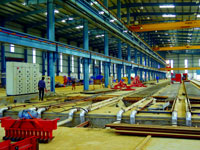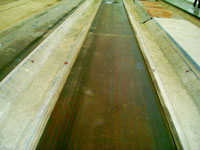Supertech Precast Technology Private Limited
Adopting Precast Technology in Building Construction
| Supertech Limited, a Delhi based enterprising entity; known for its ability to adopt innovative technologies in the real estate sector has already been setting new trends and benchmarks of architectural excellence in the contemporary global scenario. Established in 1988, Supertech has successfully completed 24 years in real estate business and has revolutionised the real estate arena with many of its landmark projects.Supertech caters to different segments of residential, commercial, townships, retail |
 |
and hospitality. The company has already converted more than 33 million sq. ft. of residential and commercial entities.
With projects worth INR 14,000 crores in hand, the company has over 75 million square feet under construction. Now Supertech is acclaimed as the one of the top real estate firm and which has grown to such heights, is the brainchild of Mr. R K Arora. It is driven by committed, visionary and dynamic leader Mr. R.K. Arora who holds the degree in Civil Engineering from Roorkee. The projects designed and constructed under the guidance of him have been highly accredited and recognized in the industry. He was also awarded the “Udyog Ratna” in the year 2001 for his contribution in real estate sector.
Supertech Limited, in its endeavour to implement the best, adopted building construction using Precast Technology well ahead of time. Considering the challenges faced in traditional style of construction, Supertech team, after immense research and effort, has launched this technology under the brand name of ‘Supertech Precast Technology Private Limited’ and has started using this construction methodology through its projects.
|
The company has set up a manufacturing unit in an area of 60,000 Square meters in Sector Ecotech-16, Greater Noida, Uttar Pradesh, India. This unit will have a production capacity of 5.0 million square feet area per annum where roofs, walls and floors of a precast house will be constructed. The Company has also set up two separate units in this factory – one for Hollow Slab and the other for Precast Wall Panels. All machines and units required to execute the process of construction is being imported from Germany.
Supertech, being the pioneers in Precast Construction will offer the technology to other players in the industry for the construction of high rise, low rise, villas, townships and many more structures.
|
 |
R. K.Arora, Chairman & Managing Director of Supertech Limited elucidates about this technology – why there is a need of such a technology and how does this work.
In precast construction, the structures are not made of mortar and cement but of beams, columns, panels, slabs and standard concrete. Such construction does not need plastering as the surface made is very smooth and requires very less maintenance. The technology strengthens the overall solidness of the house much more than a traditional house. With the use of this technology, a hindrance-free construction can be carried out in any season saving up to 64% of time as compared to the construction time of a brick house.
In a country that has a staggering housing shortfall of nearly 27 million houses and inherent project execution challenges including shortages in skilled manpower, the current execution capacity based on traditional brick and mortar is hugely limited. Housing as an industry is still hand crafted and heavily dependent on manual labour and on-site construction, which leads to large amount of material wastage, labour inefficiency and delay in project delivery. To overcome these problems, the precast technology is the best solution.
In India, affordable and mass housing needs an approach which is of component based off-site production with supply chain linkages to the material suppliers and backward linkages to create skill manpower. This will help houses to be manufactured rather than built. Due to this extensive demand of housing units, the real estate market needs mass production where this technology will be of greatest help. With speedy production process a large number of units will be delivered in short span of time at an affordable cost - this technology cuts down the construction cost by 10-15%. Also, as this technology doesn’t need skilled manpower which has a huge shortfall in India, with less manpower and advanced production process, the technology will help the real estate sector grow in a big way consequently helping the masses of India.
|
The technology can be used in construction of high rise buildings which will prove beneficial to both the developers as well as the customers. Metro cities of India such as Delhi, Mumbai, Bangalore, Kolkata and Chennai are facing a lot of space crunch with more and more people migrating to the cities everyday creating further demand for housing. With this technology, construction of high rise buildings is also possible, which is an added advantage of this technology.
|
 |
Precast Concrete Technology has already proved its worth in Europe, Dubai, Malaysia, Singapore and many other countries worldwide. The best part of the technology is that it not only speeds up the construction work but also enhances the quality of the final output. Also, it helps in creating bigger carpet area, which is of utmost importance to any customer. In a precast house, a defined space is left for windows, doors and all fittings such as Electrical, Plumbing, TV, Telephone, etc., which shall be laid before concreting. Everything will be controlled and monitored through computer which ultimately helps in making the structure stronger and better shaped.
The technology has never being used in constructing the real estate projects in India. As of now, the technology has been used only in developing infrastructure like bridges, flyovers, stadium, halls and also the Metro Rails.
Some Important aspects about Precast Technology:
- The use of this technology expedites the construction work
- The quality of the construction is better compare to normal method
- It is independent of weather conditions
- The precast panels help in creating bigger carpet area
- The use of this technology does not need plastering because it makes the surface very smooth
- Precast concrete material is corrosion resistant and can be used in very aggressive environment
- Structures like sports stadiums and halls can be constructed through this technology as the material used is such which is free from noise vibration
- Customization in structures is possible – Precast structures can be moulded as per convenience & utility.
Factory Production
|
Built Expressions in its constant endeavour to provide its reader updated information visited the factory facility of Supertech Ltd at Greater Noida, Delhi. Two main production units namely, Hollow Core Slab and Typical Architectural Wall Panel are dealt here in brief.
S P Tripathi, CEO, Supertech Precast technologies Pvt. Ltd, explained the casting and the stringent quality processes at the factory using high-tech |
 |
machineries. He has also been the recipient of many national awards.
Production Unit - Hollow Core Slabs
Hollow core is economical. Modular precast concrete floor and roof slabs are machine manufactured under controlled conditions in modern precast plants. Most slabs are 1220 mm (4’-0”) nominal width and 203 mm (8 in) deep – other sizes are available for special applications
Manufacturing
Hollow core slabs are made on long-line casting beds and cross-cut at 900 to the exact length for each project. Angle cuts are possible but cost more. It is desirable to have the plan dimensions fit the slab module, typically 1220 mm (4’-0”). Non-module plan dimensions can be accommodated using partial width slabs.
Hollow core slabs can be used for most applications requiring a floor or roof system. Schools, office buildings, condominiums, hotels, senior citizen's apartments, commercial buildings, residential dwellings, houses of worship, nursing homes and educational facilities are all ideal applications. For hotels, motels and apartments the hollow-core slabs are oriented to either span between load bearing shear walls or to span from the central corridor to the exterior walls. Slabs can be cantilevered up to 1.5 m (5 ft).
Hollow core slabs are prestressed. This means longer spans, shallow depth and the ability to carry heavy loads are easily accommodated. This also means better space planning and a lower floor/floor height. Lengthening the span is economical with fewer slabs to make and install. Maximum span/depth ratios of 45 are recommended for floors. A 203 mm (8”) slab can span up to 9 m (30 ft) depending on the loading. A 305 mm (12”) slab can span up to 14 m (45 ft) depending on the loading.
Use of Slab Voids
|
Hollow core is cast with continuous voids to reduce weight and cost and, and as a side benefit, for use to conceal electrical wiring or mechanical ducts. When properly coordinated for alignment, the voids in hollow core slabs can be used for electrical or mechanical runs. For example, routing of a lighting circuit through the cores can allow fixtures in an exposed slab ceiling without unsightly surface mounted conduit. Slabs detailed to distribute heated air through the cores can be used as the thermal mass in a passive solar application.
Finished Soffit
Hollow core, cast on smooth steel forms, has a finished underside. The smooth ceiling provided by a hollow core slab requires only caulking of the longitudinal joints. The underside of slabs can be used as a finished ceiling as installed, by textured paint, or by applying an acoustical spray.
|


|
Holes and Openings
Openings may be provided in hollow core systems by saw cutting after a deck is installed and grouted, by shoring and saw cutting, by forming or sawing the openings in the plant or by installing short slabs with steel headers. In laying out openings for a project, the least structural effect will be obtained by orienting the longest dimension of an opening parallel to a span, or by coring small holes to cut the fewest prestressing strands, or when several openings must be provided, aligning the openings parallel to the span to again cut the least number of prestressing strands.
The solid wall is fabricated in its entirety in the precast works. It can be fabricated in all structurally required thicknesses. All necessary reinforcement is inserted in the factory. Solid walls are fair faced on one surface and around their edges. The second face is struck off and smoothened – thus eliminating any on site finishing.
Lightweight concrete wall panels form part of the solid wall construction system, used above all in house building. The key advantage of lightweight concrete wall panels are their minimal weight and the resulting positive thermal insulation properties, which permit rapid, energy-saving and cost-effective building.
Model Unit
|
A two story model office building has been erected at the premises comprising of Column-Beam elements, Wall Panels, Hollow core slabs, Staircase along with modular doors and window system. This facility apart from being planned as an administrative office for the factory satisfies all the prevailing codal provisions and also acts as a unit for training the erection staff.
|
 |
Built Expressions during its visit to Supertech facility walked with Sadanand, Group CEO and posed some fundamental questions to get an overall picture about the Precast industry. Excerpts below:
With many years of experience in the precast industry, your organisation today is one of the leaders in precast industry. Brief us about the changing technological trend witnessed in the precast technology.
As such there are not changing trends anywhere in the industry. The basis of using precast technology is standardizations of elements used in construction to improve the quality of the final product and introduce time based savings. This concept is as true today as it was 50 years ago.
Advances in concrete technology leads to more efficient structural sections and help in use of pre stressed elements. Research in structural and connection design leads to use of precast in high rise buildings. There is a lot of research being done around the world for advancements of precast technology and no one can specify what the next big advancement will be.
Can you briefly explain your expertise in designing and detailing of Precast Building Structures?
We have over a period of time sourced and developed reputed Precast Designers like Innovela Building Solutions, Pune, Vahanen group, a Chandigarh based Finnish Technical consulting company, WBK Engineering Services, based at Gurgaon (basically Netherlands based)Precast technical consulting company and Melior Structural Solutions, Chandigarh based Technical consulting company.
Secondly we have our own in house team to ensure the designed elements are manufactured and erected, so the entire ground execution expertise is available in house.
Which are the signature projects in India that you are currently involved with? With reference to India, what standard practices you adopt?
Supertech has become now a brand in real estate industry and is scaling new heights. Also Supertech is first one to conceptualize the precast construction process in Indian housing scenario and has established its first Precast Factory in northern India with a view to undertake its in-house projects. In future we may target outside projects in the market.
Presently we are adopting this technology for Villa Construction, High rise building construction ( G+22) floors, Compound walls, Podiums etc.
Please tell us about the various services your organization can offer?
We have the capability of providing complete design, productions, logistic transport, and erection solutions through PRECAST method.
What are the technologies, design software and code of practice you adopt while providing your services to your customer?
Indian Codes have provision to design structures out of precast so basically we refer to Indian codes for design, regarding the production we have state of the art machineries to produce and are semi auto/sensor controlled to maintain accuracy and quality.
What are the advantages of precast concrete building structures over other conventional structures?
Advantages of precast vary from project to project depending upon the scale, usage, location and general planning of the structure. However some common benefits of using precast construction are
- Reduction in construction time.
- Less requirement of manual labour.
- Better Quality control.
- Efficiency of using advanced technologies like Hollow core slabs and Double-T slabs.
What are the various components involved in the construction of a Precast Building?
Precast construction composes of casting of different structural elements (beam, column, slabs and wall) in the factory, transporting them to the site and connecting them to final structure. This involves advance planning and design of the entire structure including logistic planning for transportation, erection and final connections of the structural elements. Planning for transportation and erection of structural members is very critical since this can make a huge difference in the time savings that can be achieved from using precast construction.
What are the variants in precast technology that are being adopted in India?
Precast technology is new in India, however precast slabs (Solid, hollow core, double-T), precast walls (R.C.C. sandwich panels), precast beams (rectangular, I-beam, band beam) and precast columns are all being used in various places. Also precast pre-stressed I-beam Girders have been used in bridges in India for a long time now.
What kind of turnkey solutions do you provide?
We can provide Design (through our associate structural designers), Produce (precast element at our factory), Transport and Erect in place. Effectively once the erection is over then one can immediately start finishing works like tiling, doors & windows etc. Because we place the electrical conduits and junction boxes etc in the factory while casting the element, for plumbing we create niche to fix pipes.
How sustainable precast concrete elements are? And how do they contribute to support the green movement?
Precast concrete is in the end only concrete. However there is an additional benefit of using advanced technologies like hollow core and Double-T slabs which reduce the overall quantity of concrete consumed. Precast concrete has many added advantages like sandwich panels which provide much better thermal and sound insulation than normal concrete walls thus helping in power consumption. As the elements are produced in the factory the pollution levels will be much under control on actual site as well as in the factory. Wastage quantity is reduced to the maximum extent. There will be hardly any disposable debris at the sites.
How the precast concrete technology can be efficiently and effectively used on various Indian projects in the light of projects under execution?
Efficiency and effectiveness of use of precast technology is not a general solution but varies greatly from project to project. However maximum efficiency of precast technology can be achieved with standardisation of elements and large scale of construction for utilisation of production capacity. To bring in the major efficiency in the design the Structural Designer to be involved right in the Architectural Concept stage so that little modifications could be suggested by the Structural Consultant to make the design precast friendly from the Structural efficiency perspective.
What are the factors to be considered when deciding to implement precast concrete construction?
Standardisation of elements, scale of construction, repetition of structural elements, availability of labour, transportation and erection facilities are some of the factors to be considered.
What is architectural precast concrete? Can you briefly explain?
Architectural precast concrete is the usage of precast elements to enhance architectural features of the structures through special shapes, colours, gradients or using additional non-structural elements like façade panels, projections, pergolas etc.
India is facing in general acute construction labour shortage. How is this problem addressed by precast technology?
Precast technology depends on reducing the direct labour and using as much mechanisation of construction as possible. This directly reduces the labour requirement; simultaneously one can save time due to mechanisation. Quality of work will then be much under control because the elements are manufactured in the controlled atmosphere in the factory.
What are the major disadvantages of precast concrete?
Efficiency of precast construction depends on various factors as mentioned above. However scale of project is the first factor to be considered, since precast factory, transport and erection equipment is a major investment that can be covered if the project is large and there is proper standardisation of the elements.
One cannot take up modifications at a later date, however additional provisions for lights, water taps etc. Could be made in the initial design only.
How do we ensure the structural integrity between two different precast elements?
The connections between the elements are designed to provide structural integrity between different elements for the forces as per structural requirements. These connections can be based on friction, concrete with reinforcement, steel connectors or proprietary connections along with high strength cementations grouts.
What are the advantages of precast wall structures compared to RCC frame structure?
Precast wall slab structures allow for
- Greater rigidity of the structure.
- Reduction of brickwork at site.
- Reduction of plastering and other site work.
- Ability to providing MEP conduits within the factory.
- Basically pre casting will provide the controlled environment to produce the quality product.
How are the other MEP services integrated in the precast panels? Do they provide us any flexibility at a later date to alter the interior layout?
MEP conduits are generally placed in the panels during casting and thus cannot be changed at a later stage. However grooves or cuts can be placed in advance if some changes are expected.
There is flexibility of changing internal layout provided no structural members are changed. This has to be planned at the initial stage so that non-structural elements are predefined and the connections are made considering the requirement to be removed at a later stage.
Acknowledgements: Built Expressions is grateful to Mr. Sadanand, Group CEO & Executive Director, Mr. S P Tripathi, CEO, Supertech Precast technologies Pvt. Ltd and, M/s Supertech Limited, for their inputs and courtesy extended during our visit.
www.supertechlimited.com
Ph.: +91-120-4572600